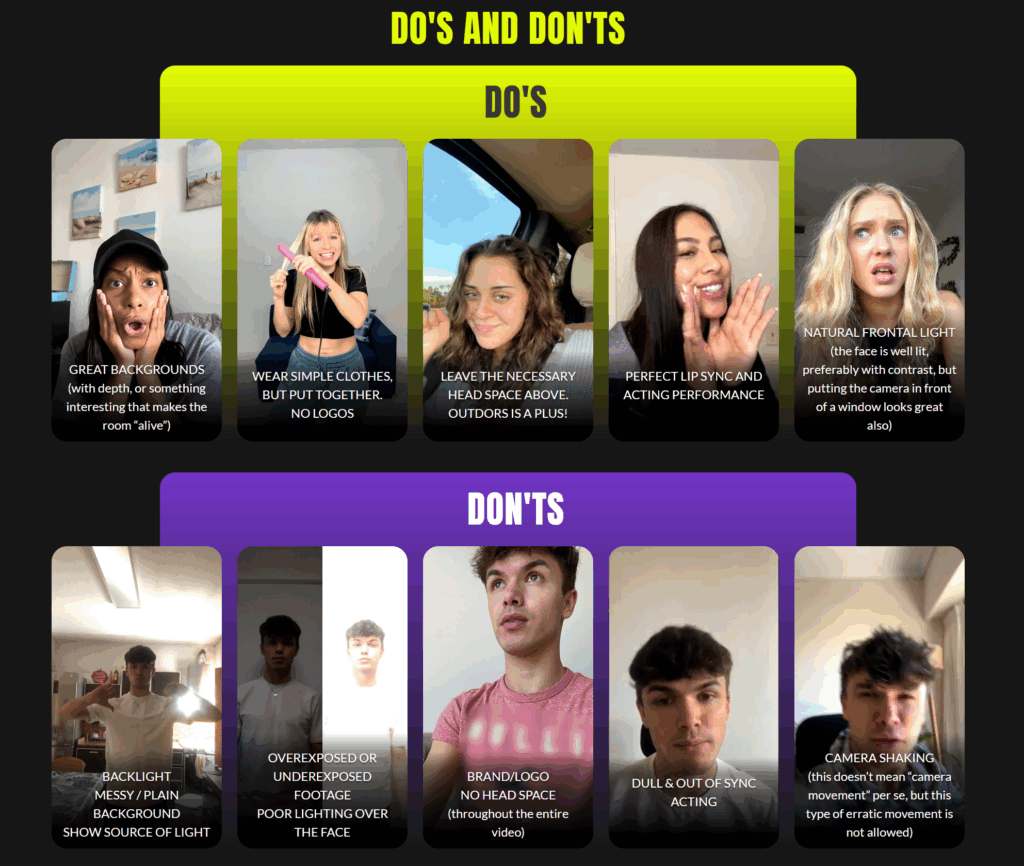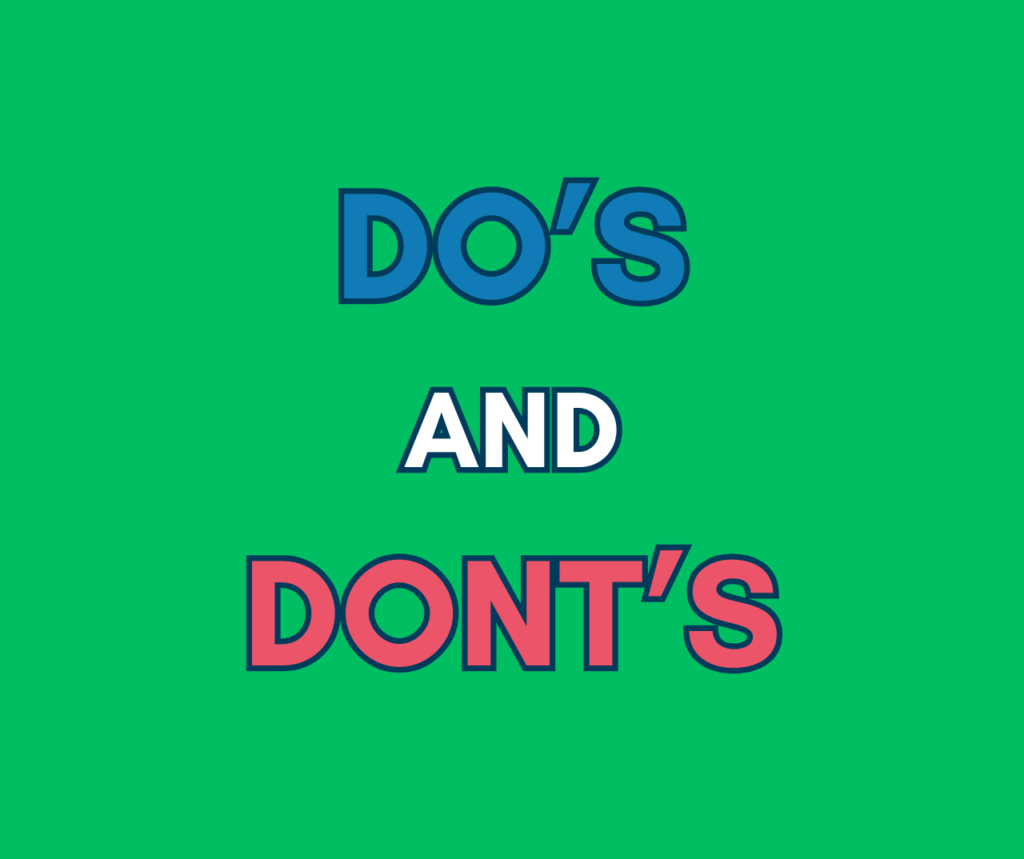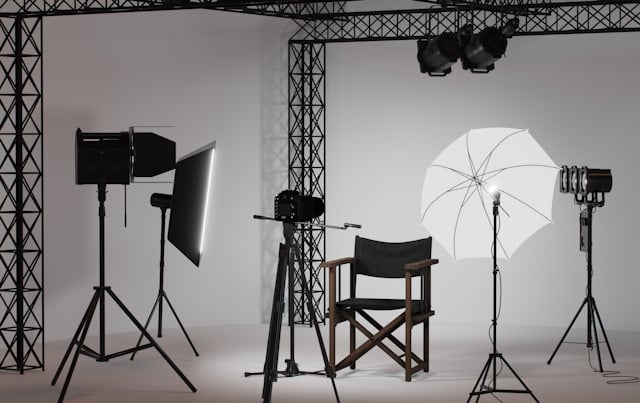
When it comes to creating compelling short-form video content, we (humans) are all over the place when it comes to the Quality, Story, Performance, and Engagement.
Here is an extensive list of dos and don’ts for creating compelling UGC Video content. You can use this for yourself or share it with your consumers to follow.
Visual and Audio Quality
DO:
- Choose backgrounds with depth and interest. Film in settings that enhance your story, stylish rooms or outdoor scenes with layers and textures engage viewers without distracting from you or your product.
- Frame your shot well and leave head space. Keep the camera steady, allow some space above your head, and use the “rule of thirds” for balanced composition. A tripod or stabilizer helps avoid shaky footage.
- Use natural, frontal lighting. Face a window or film outside for soft, even light. If indoors, use diffused lights to avoid harsh shadows or overexposure. The goal is to be well-lit and clearly visible.
- Capture clear audio. Record in a quiet space and speak toward the mic. Use an external mic if possible, and watch for background noise. Test audio levels to ensure your voice is clear and not distorted.
DON’T:
- Avoid poor lighting or backlighting. Don’t film with bright lights or windows behind you, as this creates silhouettes. Check your camera to avoid overexposure or underexposure, and keep light sources out of the frame.
- Don’t use messy or dull backgrounds. Cluttered or blank backgrounds distract or bore viewers. Tidy up and add relevant décor so your environment feels intentional and supports your story.
- Don’t create shaky videos. Avoid jerky camera movements. Use a steady hand or stabilizer, and edit out accidental shakes for a professional look.
- Don’t ignore video format and quality. Always film vertically (9:16) for short-form platforms, and use HD resolution (1080p or higher). Avoid grainy footage or wrong aspect ratios, which look unprofessional and turn viewers away.
Storytelling and Content
DO:
- Start with a hook. In short-form video, the first 2–3 seconds are crucial to grab attention and prevent viewers from scrolling away. Use a bold statement, surprising visual, question, or exciting sound right at the start. Jump straight into the action with no long intros or logos. 71% of viewers decide to keep watching within the first few seconds, so lead with your strongest content.
- Tell a relevant, authentic story. Build your video around a narrative that resonates with your audience and connects to your brand. Use personal anecdotes, quick demos, or mini-vlogs that feel genuine, like a friend sharing a tip. Ensure your story or trend aligns with your brand message and audience interests. For example, brands can join trends but relate them back to their product in a fun, relevant way.
- Keep it concise and impactful. Aim for 15–30 seconds, generally under a minute. Focus on one main point, showing the most important content first. Use quick cuts and snappy pacing to maintain energy. Concise, value-packed videos hold attention and often loop automatically, boosting engagement. Some creators design videos to loop seamlessly for extra views.
- Leverage trends and music wisely. Use trending sounds, music, memes, or challenges that fit your brand to increase reach and show you’re current. Creatively incorporate your product into trends, but always tie it back to your message so it feels natural. Only use music or sounds you have rights to or that the platform provides.
- Plan your content (but stay flexible). Outline your key message and plan shots or captions for an organized flow like a quick script or shot list. This helps you hit all your points efficiently. However, stay flexible and embrace genuine, spontaneous moments to keep your content authentic and engaging.
DON’T:
- Don’t make it overly salesy or scripted. Hard sells and infomercial vibes turn viewers off quickly. Skip corporate jargon, slogans, feature lists or phrases like “Introducing the revolutionary XYZ…” They sound like ads and make people skip. Instead, focus on sharing, not selling; UGC should feel like friendly advice or a story. Don’t read scripts word-for-word. The natural, unscripted videos are more engaging. Know your key points and speak in your own conversational style.
- Don’t stray off-topic or cram in too much. With just 30 seconds, stick to one clear message or story. Don’t try to fit in introductions, tutorials, testimonials, and company history all at once. Avoid unrelated tangents or jokes unless they support your main point. Keep every clip or sentence focused on the story or feeling you want to convey.
- Don’t ignore platform trends. Each platform has its own style and audience. What works on TikTok may flop on Instagram. Don’t force a corporate style if the trend is casual, and don’t use trendy memes if they don’t fit your brand. Research the platform’s pacing, language, and editing styles, and avoid outdated formats. Make sure your content feels native and relatable.
- Don’t violate trust or guidelines. Never include anything offensive, misleading, or dishonest. Audiences spot inauthenticity, and exaggerated claims erode trust. Avoid unlicensed music or banned hashtags that could hurt your video’s reach. Stay positive, follow platform rules, and keep your content brand-safe to protect your reputation.
Creator Performance and Presentation
DO:
- Present yourself professionally (yet authentically). As a creator in a brand campaign, aim to be both relatable and polished. Wear simple, neat clothing without loud patterns or visible logos (unless it’s the brand you’re promoting) to keep the focus on you and the product. Follow brand guidelines and choose attire that matches the campaign vibe. Comfort and confidence in your outfit will show on camera.
- Bring energy and emotion to your performance. Short-form videos need personality. Smile, use expressive body language, and let your passion show. Speak clearly and enthusiastically, as if sharing with a friend. For voiceovers, add warmth to avoid sounding monotone. Authenticity is key; viewers notice if you’re faking it, so show real excitement when you feel it. Genuine reactions make your content more relatable and memorable.
- Practice your lip-sync or voiceover timing. Many UGC videos use trending sounds or music. Practice to sync your mouth and actions with the audio for a polished result. A well-synced performance keeps viewers engaged. When acting out skits or reactions, commit fully, and some exaggeration can help your performance stand out on camera.
- Mind your body language and eye contact. Look at the camera lens to connect with viewers. Maintain an open, friendly posture and use natural gestures. When demonstrating a product, hold and use it naturally. As the host of your mini-show, appearing engaged and confident with a genuine smile and good posture boosts your credibility and likability.
DON’T:
- Don’t wear distracting or branded clothing (unless it’s on-message). Avoid shirts or hats with big logos, brand names, or loud graphics, as they can confuse viewers or violate brand rules. Dress cleanly and appropriately, steering clear of anything that clashes with the brand image, like competitor merchandise. Aim for a stylish yet neutral look to keep the focus on your video content.
- Don’t be dull or low-energy on camera. Speaking in a monotone or looking bored will lose viewers fast. Don’t film when tired or in a bad mood, and avoid just reading a script with no emotion. Show natural enthusiasm, but don’t be overly fake or rehearsed. Authentic moments, like a quirky laugh, can be endearing, just remember to bring extra energy for the camera.
- Don’t let technical mishaps undermine your performance. Check for things like food in your teeth, a dirty lens, or an unflattering camera angle. Clean up, set your camera at eye level, and avoid awkward framing. Remove distractions so your on-screen presence shines.
- Don’t ignore feedback or guidelines from the brand. Always follow the brief and required disclosures. If the brand asks for changes, don’t take it personally; they know their goals. Ignoring feedback or guidelines can ruin a campaign. Collaboration and flexibility are key to successful brand partnerships.
Engagement and Viewer Experience
DO:
- Engage the viewer directly. Treat your audience as participants by asking questions or encouraging interaction, like, “Which outfit do you like better? Let me know in the comments!” This boosts engagement and makes viewers feel involved. Many top UGC creators use captions or on-screen text to prompt responses, such as ending with, “What questions do you have about life insurance? Ask away in the comments.” Also, respond to comments to show there’s a real person behind the video, which builds loyalty and helps with algorithms.
- Use on-screen text or captions for clarity. Many viewers watch with the sound off, so add short text callouts, subtitles, or graphics to ensure your message is clear. For example, flash “3 tips for better skin” on screen as you say them. Captions aid understanding, catch attention, and improve accessibility. Use auto-caption features, but avoid clutter. Aim for a balance so viewers can follow along even with the volume off.
- Optimize for a smooth viewing experience. Keep videos vertical and mobile-friendly. Trim pauses for a snappier pace, and consider seamless loops to encourage repeat views. Use platform-specific features like trending sounds, interactive stickers, or compelling thumbnails to boost engagement and make your content more interactive and enjoyable.
- Include a call-to-action (CTA) when appropriate. Guide viewers on what to do next, such as “Check out the link in my bio” or “Use code SAVE20 at checkout.” Make CTAs feel natural and relevant to your content. Even a simple “Drop a comment if you found this helpful!” can turn engagement into measurable results and align with your campaign goals.
DON’T:
- Don’t make viewers strain to watch or listen. Eliminate friction in the viewing experience: avoid tiny text, fast-flashing images, or cluttered visuals. Fun edits are good, but too much overwhelms. Ensure audio is clear: background music should support, not overpower, your voice. Remember TikTok and Reels may cover screen edges, so keep key info away from corners. Always test-watch before posting to confirm everything is easy to see and hear. If the content is hard to follow, viewers will move on.
- Don’t forget to deliver value or entertainment. Every short-form video should educate, entertain, or inspire. Ideally more than one. Don’t post just to post; offer a takeaway, whether it’s a laugh, a tip, or a relatable moment. Avoid filler or repetitive trends without a personal twist. Keep the whole video engaging, not just the ending. The best influencer UGC makes viewers smile, relate, or learn. Respect viewers’ time by rewarding it with quality content.
- Don’t be afraid to be human. Don’t edit out every imperfection. Include candid laughs or genuine reactions to keep your content authentic. Over-produced, overly filtered videos feel inauthentic. In 2025, audiences want authenticity, not perfection. A brief blooper or honest moment can boost engagement. Keep it clean and on-message, but let your personality shine through; viewers connect more with real people.
- Don’t ignore the community after posting. Engagement doesn’t end at upload. Respond to comments and questions to build goodwill and boost reach. Don’t escalate with trolls, respond kindly, or ignore. Brands and algorithms value ongoing interaction. Simple replies or answering FAQs in comments can increase engagement. Handle negative feedback gracefully, and let brand managers step in if needed. Being present and positive after posting amplifies your video’s impact.
Conclusion
Short-form UGC videos are a powerful way for brands to boost consumer engagement when executed well. The key is balancing authentic, creator-driven content with quality and strategy that support brand goals. Best practices include maintaining high production standards (good lighting, clear audio, appealing visuals), staying native to the platform, telling a compelling, genuine mini-story, presenting with enthusiasm, and focusing on the viewer’s experience.
By following these guidelines: using strong visuals, hooking viewers early, delivering a focused, personable message, and encouraging interaction brands can greatly improve influencer UGC campaign success. The most effective strategies blend professional polish with authenticity, combining brand standards with a relatable creator voice. This approach produces videos that look great and feel real, inspiring viewers to engage and trust the message.
Empower your creators with these tips, encouraging creativity within clear quality and brand guidelines. The result: short-form videos that captivate audiences and drive real engagement. In 2025’s fast-paced social landscape, mastering authentic, strategic UGC will set your brand apart. Now, brief your creators and watch your campaigns thrive, happy filming!!







